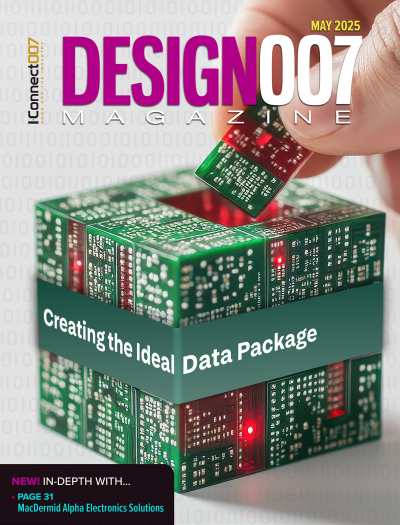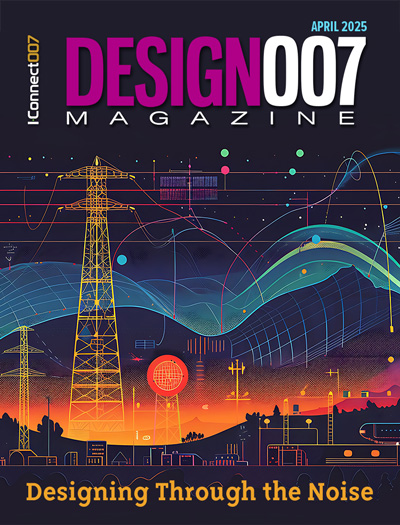-

-
News
News Highlights
- Books
Featured Books
- design007 Magazine
Latest Issues
Current Issue
Creating the Ideal Data Package
Why is it so difficult to create the ideal data package? Many of these simple errors can be alleviated by paying attention to detail—and knowing what issues to look out for. So, this month, our experts weigh in on the best practices for creating the ideal design data package for your design.

Designing Through the Noise
Our experts discuss the constantly evolving world of RF design, including the many tradeoffs, material considerations, and design tips and techniques that designers and design engineers need to know to succeed in this high-frequency realm.

Learning to Speak ‘Fab’
Our expert contributors clear up many of the miscommunication problems between PCB designers and their fab and assembly stakeholders. As you will see, a little extra planning early in the design cycle can go a long way toward maintaining open lines of communication with the fab and assembly folks.
- Articles
- Columns
Search Console
- Links
- Media kit
||| MENU - design007 Magazine
Sunstone Integrates SnapEDA Libraries into PCB123
October 25, 2017 | Andy Shaughnessy, PCB Design007Estimated reading time: 6 minutes
Sunstone Circuits and SnapEDA recently announced that SnapEDA’s parts library would be integrated into Sunstone’s PCB123 design tool. During PCB West, I interviewed EDA Product Manager Nolan Johnson of Sunstone Circuits and SnapEDA President Natasha Baker. We discussed their new partnership, the changing parts library landscape, and where the companies see this alliance heading in the future.
ANDY SHAUGHNESSY: I'm here today with Nolan Johnson and Natasha Baker, who have a pretty big announcement regarding their two respective companies. Nolan, why don't you start off? Tell us what this announcement is about.
NOLAN JOHNSON: Sure. We're excited to be partnering with SnapEDA to bring their utilities into our PCB123 design environment. PCB123 is a free-to-use tool, with no license fees, no subscription fees. We've been around for quite a while and have a very strong following with users, both industrial and individual. It’s incredibly powerful for us to be bringing SnapEDA into the mix, because now we have native parts access inside the design tool. As designers are making parts decisions to go into their schematic or their layout, they will now have access to a cloud-based database of millions of parts that are verified “good.” Not only that, but SnapEDA report current part availability data as well, so you don’t inadvertently design in an obsolete part.
This makes it much more efficient for the designers to get their designs done. Statistics show that something like 35% of a project is spent defining new parts that the designers don't already have. We've just made that go away through this partnership.
SHAUGHNESSY: Natasha, tell us a little bit about SnapEDA and how this all works.
NATASHA BAKER: SnapEDA built the Internet's first parts library for circuit board design. Taking a look at our conversations with designers, what we found was that one of the biggest pain points in designing electronics is that they couldn't find the parts they needed for their designs, or I should say, the content they needed. When you're designing a circuit board, there are all types of content that you need to represent your components, whether that's to capture your schematic, simulate the circuit, or lay out the circuit board.
What we thought was: What if we could create one centralized place engineers can go to get trusted data and trusted content that is needed at all stages of this design flow? So that's why we created SnapEDA. Basically, the philosophy we have at SnapEDA is to bring a breadth of content across all these stages of the design flow. This means interoperability—ensuring that it works with tools such as PCB123—and also transparency into the quality of the data. Because one of the biggest challenges at every stage of the design flow is, "Can I trust this design content?"
And so a lot of our initiatives have been around creating one standardized data base that's customizable to your company and application-specific requirements, and at the same time it can give you transparency into what standards that content was created with. So, we're applying this to symbols and footprints today, and that's now available in PCB123, as well as in the long term with all types of content that we're going to be creating in the future, whether that's 3D models or even simulation models. It’s the same philosophy.
SHAUGHNESSY: It’s interesting because this was what you were talking about doing all along. This certainly seems like a big step for your company.
BAKER: Yes, absolutely. One thing that's really exciting about this launch with PCB123 is that this is actually the first time in the industry that a desktop, traditional PCB design tool, has integrated a cloud-based library natively. So, you don't need to install any plug-ins. It’s not behind a pay wall. This is something that every single designer who downloads the latest version of PCB123 will have access to immediately, and so they'll benefit from right in the desktop tool they know and trust. They're going to benefit from all the great features of a cloud-based library, including a parts library that's updated daily, the ability to see real-time verification checks in the library, as well as communicate with other community members to vet the quality of the data or ask questions about it. And then finally, they can also request parts and get them in 24 hours. The library is updated for the entire PCB123 and electronics community to download that part for free.
SHAUGHNESSY: Nolan, we were talking earlier about how designers like their layout tools to be on the desktop, they've never been big fans of the cloud, but now the cloud works well with parts libraries.
JOHNSON: Right. This is the right stuff to be putting in the cloud, since a library is well suited to being maintained in a centralized way. There are a lot of opportunities for how the library can be managed, whether it’s through end-users who are collaborating, or through semiconductor companies who are pushing parts definitions down into this for distribution so as to make it easier for designers to use that particular chip company’s parts. There are all sorts of dynamics here. The transparency can't really be overstressed at all. It’s particularly interesting.
Any designer who's reading through this probably has had the experience where they've gotten the uncomfortable call from the assembly house saying, "We've got your parts, we've got your board, but these parts don't fit on the board because the footprint's wrong." That's the wrong time to be getting that message. SnapEDA’s new dynamic now allows for better parts—more verified parts, more accurate parts, all in one place where the user can make a good parts choice during their research and part selection phase, and then have that parts definition accuracy roll down through the design phase to a better fab, and a better assembly experience in the end.
SHAUGHNESSY: Is it full function? Are you going to add more functionality to it later?
BAKER: We definitely have a roadmap. Our teams have discussed the next steps, and we're also looking for feedback from PCB123 users. That being said, we definitely have a couple of things that we're looking to add next, including user authentication to allow for direct downloads right inside PCB123, and then the ability to request a part directly from PCB123.
SHAUGHNESSY: And if people are coming to you wanting to know where to get their boards done, then you can steer them to the right manufacturer.
BAKER: Yeah, at some point we definitely want to, but it's not something we're focused on right now. We’re currently really focused on our data and how we can build the best source of data, the most trusted source of data. That being said, a lot of our designers have PCB manufacturing needs, so we're trying to figure out when we would do that and what it might look like, but really our focus is just on the content right now. Hopefully this is a great resource because it’s a free PCB design tool, and like Nolan said, it’s completely open. The Gerbers are completely open. You're not locked in. So this is a wonderful opportunity for people to learn about PCB123 and Sunstone.
SHAUGHNESSY: Great. Well, this sounds like an exciting time for both of your companies. Thanks for sharing this with us today.
BAKER: Thank you.
JOHNSON: Thanks, Andy.
Suggested Items
CE3S Launches EcoClaim Solutions to Simplify Recycling and Promote Sustainable Manufacturing
05/29/2025 | CE3SCumberland Electronics Strategic Supply Solutions (CE3S), your strategic sourcing, professional solutions and distribution partner, is proud to announce the official launch of EcoClaim™ Solutions, a comprehensive recycling program designed to make responsible disposal of materials easier, more efficient, and more accessible for manufacturers.
WellPCB, OurPCB Launch Low-Cost PCB Assembly and Custom Cable Assembly Solutions
05/29/2025 | ACCESSWIREWellPCB and OurPCB, world leading PCB manufacturing service providers, announced today that they have officially launched new Low-Cost PCB Assembly Solutions and Custom Cable Assembly services to meet the needs of the electronics manufacturing industry for high cost performance and flexible customization.
Siemens Expands OSAT Alliance Membership to Build Domestic Semiconductor Supply Chains
05/29/2025 | SiemensSiemens Digital Industries Software announced the latest members to join its OSAT Alliance program which enables outsourced semiconductor assembly and test (OSAT) providers to develop, validate and support integrated circuit (IC) package assembly design kits (ADKs) that drive broader adoption of emerging technologies by fabless semiconductor and systems companies and help to build secure domestic semiconductor supply chains.
Standards: The Roadmap for Your Ideal Data Package
05/29/2025 | Andy Shaughnessy, Design007 MagazineIn this interview, IPC design instructor Kris Moyer explains how standards can help you ensure that your data package has all the information your fabricator and assembler need to build your board the way you designed it, allowing them to use their expertise. As Kris says, even with IPC standards, there’s still an art to conveying the right information in your documentation.
High-frequency EMC Noise in DC Circuits
05/29/2025 | Karen Burnham, EMC UnitedEMC isn’t black magic, but it’s easy to understand why it seems that way. When looking at a schematic like that in Figure 1, it looks like you’re only dealing with DC signals all across the board. There’s a 28 VDC input that goes through an EMI filter, then gets converted to 12 VDC power. Except in extremely rare circumstances involving equipment sensitive to magnetostatic fields, DC electricity will never be part of an EMC problem.


